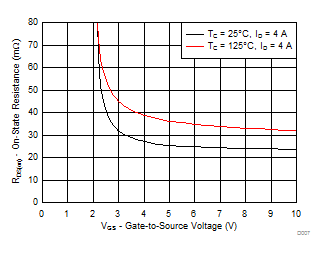SLPS260E March 2010 – September 2015 CSD17313Q2
PRODUCTION DATA.
- 1Features
- 2Applications
- 3Description
- 4Revision History
- 5 Specifications
- 6Device and Documentation Support
- 7Mechanical, Packaging, and Orderable Information
Package Options
Refer to the PDF data sheet for device specific package drawings
Mechanical Data (Package|Pins)
- DQK|6
Thermal pad, mechanical data (Package|Pins)
Orderable Information
5 Specifications
5.1 Electrical Characteristics
TA = 25°C (unless otherwise noted)5.2 Thermal Characteristics
TA = 25°C (unless otherwise noted)| PARAMETER | MIN | TYP | MAX | UNIT | |
|---|---|---|---|---|---|
| RθJC | Thermal resistance junction-to-case(1) | 7.4 | °C/W | ||
| RθJA | Thermal resistance junction-to-ambient(1)(2) | 67 | °C/W | ||
(1) RθJC is determined with the device mounted on a 1 inch2 (6.45 cm2), 2 oz. (0.071 mm thick) Cu pad on a 1.5 inch × 1.5 inch (3.81 cm × 3.81 cm), 0.06 inch (1.52 mm) thick FR4 PCB. RθJC is specified by design, whereas RθJA is determined by the user’s board design.
(2) Device mounted on FR4 material with 1 inch2 (6.45 cm2), 2 oz. (0.071 mm thick) Cu.
 |
Max RθJA = 67°C/W when mounted on 1-inch2 (6.45-cm2) of 2-oz. (0.071-mm thick) Cu. |
 |
Max RθJA = 228°C/W when mounted on a minimum pad area of 2-oz. (0.071-mm thick) Cu. |
5.3 Typical MOSFET Characteristics
TA = 25°C (unless otherwise noted)

| ID = 4 A | VDS = 15 V |

| ID = 250 µA |








